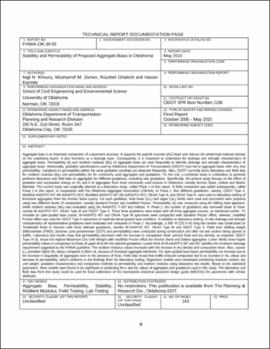| dc.description.abstract | Aggregate base is an important component of a pavement structure. It supports the asphalt concrete (AC) layer and reduces the wheel load-induced stresses on the underlying layers. It also functions as a drainage layer. Consequently, it is important to understand the drainage and strength characteristics of aggregate bases. Permeability (k) and resilient modulus (MR) of aggregate bases are used frequently to identify drainage and strength characteristics of aggregate bases. Historically, gradation specifications used by Oklahoma Department of Transportation (ODOT) have led to aggregate bases with very low permeability. Variations in permeability within the same gradation envelope are observed frequently. Also, ODOT currently lacks laboratory and field data for resilient modulus (MR) and permeability (k) for commonly used aggregates and gradations. To this end, a combined study is undertaken to generate pertinent laboratory and field data on aggregates for different gradations, including new gradations. Specifically, the present study focuses on the effect of gradation and compaction energy on MR and k of aggregates from three commonly used sources in Oklahoma, namely Anchor Stone, Dolese and Martin Marietta. The current study was originally planned as a laboratory study, called Phase 1 in this report. A field component was added subsequently, called Phase 2 in this report, in cooperation with the Oklahoma Aggregate Association (OKAA). In Phase 1, five different gradations, namely, ODOT Type A, Modified AASHTO #57 (M-AASHTO #57), Modified AASHTO #67 (M-AASHTO #67), OKAA Type N, and OKAA Type K, were used in laboratory testing of limestone aggregates from the Anchor Stone quarry. For each gradation, both lower (LL) and upper (UL) limits were used and specimens were prepared using two different levels of compaction, namely standard Proctor and modified Proctor. Permeability (k) was measured using the falling head approach, while resilient modulus (MR) was evaluated using the AASHTO T-307 test method. In Phase 2, the number of gradations was narrowed down to three, namely M-AASHTO #57, OKAA Type M and ODOT Type A. These three gradations were tested with all three aggregate sources, as mentioned earlier. To simulate an open-graded base course, M-AASHTO #57 and OKAA Type M specimens were compacted with standard Proctor effort, whereas, modified Proctor effort was used for ODOT Type A specimens to replicate dense-graded base condition. In addition to laboratory testing, in-situ drainage and strength characteristics of representative gradations were evaluated and compared in Phase 2. Accordingly, a 500–ft (152.4 m) long test section was constructed on Timberdell Road in Norman with three selected gradations, namely M-AASHTO #57, OKAA Type M and ODOT Type A. Field tests (falling weight deflectometer (FWD), dynamic cone penetrometer (DCP) and permeability) were conducted during construction and after the test section being opened to traffic. Laboratory test results show that permeability decreases with the increase in compaction level, percent fines and dry density, as expected. ODOT Type A UL shows the highest Maximum Dry Unit Weight with modified Proctor effort for Anchor Stone and Dolese aggregates. Lower limits show higher permeability values in comparison to those of upper limit for the selected gradations. Lower limit of M-AASHTO #67 and #57 satisfies the minimum drainage requirement suggested by the FHWA guideline. The resilient modulus values increased with the increase in dry density and compaction level. Also, coarser LL provided higher MR values compared to finer UL because of increased aggregate interlocks. For open-graded base layers permeability can increase due to the increase in angularity of aggregates even in the presence of fines. Field data reveal that traffic-induced compaction led to an increase in MR values and decrease in permeability, which conforms to the findings from the laboratory testing. Regression models were developed correlating moisture content, dry unit weight, gradation characteristics and compaction methods to permeability and resilient modulus using laboratory test results. Based on the statistical parameters, these models were found to be significant in predicting the k and MR values of aggregates and gradations used in this study. The laboratory and field data from this study could be used for local calibration of the mechanistic-empirical pavement design guide (MEPDG) for pavements with similar attributes. | |
